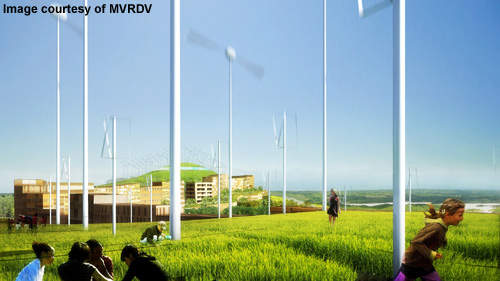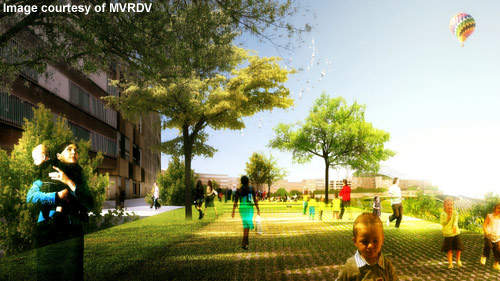In La Rioja, Spain, a northern province famous for wine, government officials have approved a plan for an eco city. Ideally, the Logroño Montecorvo eco city will be a carbon-neutral community in which residents use only solar and wind energy generated on site.
The Dutch firm MVRDV (based in Rotterdam) and the Spanish firm Gras (with offices in Madrid and Palma de Mallorca) collaborated to win first prize in a 2008 competition for the design of this city.
MVRDV is known for creating dense, stacked spaces while Gras emphasises collaboration. The two firms have also collaborated on the BCN business park (a mix of offices and factories) in Martorell, Spain, a project still in the design phase.
The Logroño Montecorvo eco city will provide nearly 3,000 housing units for approximately 130,000 inhabitants. In addition to flats, buildings will contain schools, shops, restaurants, sports facilities and areas for socialising.
Eco city site
Logroño, the capital of La Rioja, is home to nearly 150,000 people. The Ebro River, Spain’s most voluminous river, flows through Logroño. The area is mountainous; the elevation of Logroño is 384m.
Across the river, to the north, is a sparsely populated area with two small hills, Montecorvo and la Fonsalada. Because both are arid and steep, some say they have little environmental value and that building an eco city there would be an enhancement.
The Logroño Montecorvo eco city will span the two hills, with all the buildings arranged in a serpentine line stretching more than 1km. The buildings will have a north-south orientation, providing optimal natural lighting and natural ventilation.
Buildings will cover about 11% of the 56ha site. Another 73% will be a combination of green space (including wind and solar farms) and paved areas (such as pathways). Finally, 16% will be a highway into the city. The idea is to build compactly, minimising the impact on the landscape.
Energy and water sources
Because the slopes of the mountains face south, it will be easy to harness and generate solar power. Photovoltaic cells will cover the mountains and the roofs of some buildings. According to one estimate, sourcing solar power in this way eliminates the emission of 3,500t of greenhouse gases annually. To the north of the buildings, windmills on top of the hills will provide the rest of the energy.
For irrigation, the city will reuse 200,00m³ of grey water each year. The community will also have water purification systems.
Building design and function
The long, snaking line of interconnected buildings will feature volumes of different heights, skins and window arrangements. But each unit will have an identical or virtually identical layout.
To take housing blocks as an example, a ten-storey northern unit will include three storeys of underground parking, a ground floor for the public and six storeys of apartments. To the south of that, another building will provide one storey of underground parking and three storeys of housing. Bridges will connect the northern and southern buildings. The same layout applies when the buildings serve other functions.
Each unit will have a view to the south, enabling residents to see Logroño and other parts of La Rioja. Given the steepness of the hill, the southern buildings will not block views from the northern buildings.
Southern units will feature green roofs with porous paving. Residents can socialise on these plazas.
Transportation
At its highest point, a funicular will terminate at a museum and viewing point hidden in a research and promotion centre for renewable and energy-efficient technology. This centre will be hidden in the top of one hill. It is unclear how far down the hill the funicular will go, or how many funiculars will serve the city.
Criticism
The concept has generated some criticism, including questions about why an ‘eco city’ would encourage reliance on motor vehicles. Other critics wonder where all the building materials will come from and how the project will offset the carbon generated during the sourcing and transportation of those materials. Such critics accuse the architects and developers of ‘greenwashing’.








